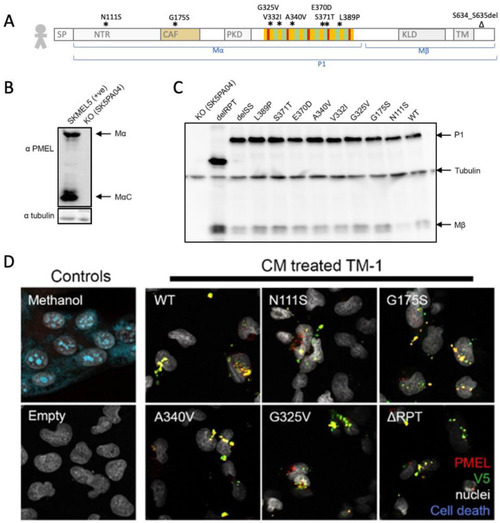
Human PMEL is engulfed by trabecular meshwork cells, providing a potential route for pigment cell defects to influence ocular drainage and glaucomatous increases in intraocular pressure. However, our surface-level phenotyping of TM-1 cell health did not reveal any overt toxicity to the cells engulfing patient variant PMEL; further work is warranted before any confident interpretations about the lack of toxicity or functional disruption can be concluded. (A) Schematic of human PMEL protein (in sync with Figure 2A), detailing the identity of pigmentary glaucoma patient variants. Details of the repeat region are simplified/omitted here, but they are presented in Figure S1. PMEL processing via cleavages produces bands Mα, Mβ and P1, with the latter two being detectable by a C-terminal V5 tag. Symbols * and ∆ indicate positions of pigmentary glaucoma patient variants, including an enrichment of missense mutations in the repeat domain. (B) SKMEL5 cells were edited with CRISPR to knockout (KO) endogenous PMEL, generating clone SK5PA04 that showed a lack of PMEL when immunoblotted with anti-PMEL antibody HMB45. (C) Patient variant PMEL with V5 tag was transfected into SK5PA04 cells and blotted with V5 antibody. (D) Trabecular meshwork cells (TM-1) engulfed PMEL (V5-tagged) supplied by conditioned media from transfected SK5PA04 cells; notice the lack of signal in TM-1 cells incubated with conditioned media from SK5PA04 cells with empty vector. Engulfment of patient variant PMEL did not lead to a detectable reduction in cell viability, but further work would be needed to assess long-term health and function of these TM cells, perhaps including the use of in vivo platforms.
|

